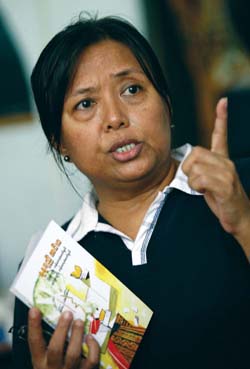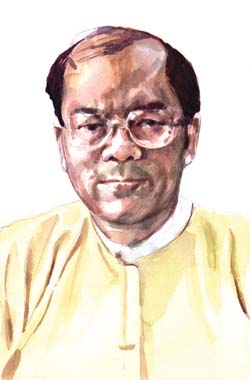
| DECEMBER, 2008 - VOLUME 16 NO.12 |
Iron Cross
 |
| Iron Cross, Burma’s best-known rock band, joined the Cyclone Nargis relief effort with a fundraising concert in Rangoon. |
Burma’s top rock band, also known as IC, is 17 years old but still hammering out a beat. When it was formed in 1991—by five musicians led by the late guitar virtuoso Saw Bwe Hmu, an ethnic Karen Christian—it played mostly cover versions of foreign numbers with Burmese lyrics. But songwriters Maung Maung Zaw Latt and L Phyu freed it from its reliance on such popular American bands as Metallica and won it critical acclaim and a wide public.
The other founders of Iron Cross were lead guitarist Chit San Maung, bassist Khin Maung Thant, keyboard player Ba Nyar Naing and drummer Kha Yan.
A later addition to the group, lead singer Lay Phyu (not to be confused with songwriter L Phyu), rapidly acquired a huge following but inexplicably disappeared from the concert scene in 2006—reappearing in August 2008 at a Cyclone Nargis relief concert given by Iron Cross. No explanation was given for his two-year absence.
About 50,000 fans packed Rangoon’s Thuwanah Sports Stadium for the Nargis fundraiser—the largest concert audience ever seen in Burma.
Joining Lay Phyu on the program were three other popular IC rockers—Ah Nge, Myo Gyi and Wyne Wyne.
Thee Lay Thee & Say Yaung zon
 |
| Thee Lay Thee & Say Yaung Zon after a performance in Chiang Mai, Thailand, in January 2008. (Photo: Moe Kyaw/The Irrawaddy) |
Consisting of five male comedians—Godzilla, Sein Thee, Pan Thee, Kye Thee and Zee Thee—and two female dancers—Mya Sabae Ngone and Chaw Suu Myo—the group is known especially for cracking jokes and performing satirical skits at the expense of the Burmese junta.
Last November, the troupe performed on Myaw Zin Gyun, an islet in Rangoon’s Kandawgyi Lake. They had been asked by the authorities to sign a document saying they would not make political jokes on stage. But that did not stop them from directing their wit at the regime’s savage crackdown on demonstrating monks last September. A VCD of their performance became a huge hit and was immediately banned by the authorities.
The VCD soon traveled beyond the country’s borders, and the troupe was invited by Burmese communities in Thailand, Malaysia, Singapore, South Korea and Japan to perform in these countries.
The troupe said their jokes were inspired by real events on the streets of Burma, and expressed the “real voice of the people.”
“We just have to listen to the voice of the people, and then we reflect on their lives,” said Godzilla.
Nay Toe
 |
| Nay Toe’s next film will help raise funds for the Cyclone Nargis relief effort. |
Nay Toe was busy filming when Cyclone Nargis struck, and he still regrets that he couldn’t join other personalities in taking aid to the victims in the Irrawaddy delta. But he donated about 3.8 million kyat (more than US $3,000) to the relief effort.
“I felt very sad at that time” he said. “I would like to give [the cyclone victims] as much as I possibly can.”
Nay Toe completed two films in 2008, “Tharaphu” and “Zaw Ka Ka Nay The,” and he’s being tipped to take at least one of Burma’s own Academy awards.
Nu Nu Yi (Inwa)
 |
| Nu Nu Yi’s novels focus on the fringes of Burmese society. (Photo: AFP) |
But a new novel featuring the festival—which attracts members of Burma’s gay community, many of whom participate in a ritual marriage with Nats—has inspired anything but pride among Burmese officials.
“The authorities said the story was against the customs of Theravada Buddhism and Burmese culture,” said author Nu Nu Yi, who spent three years researching and writing “Smile As They Bow, Laugh as They Bow.”
“Homosexuality is banned officially in Burma,” she said.
Her novel, which describes the relationship between a gay spiritual medium and a young Burmese man, won the 2007 Man Asian Literary Prize. It was also translated into English and published by Hyperion in 2008.
Nu Nu Yi was born in Inwa village, near Mandalay, in 1957. Since starting her literary career in 1984, she has written 15 novels, 100 short stories and many articles in well-known Burmese magazines. Most of her writing is set among Burma’s rural poor and social outcasts.
Kyi Phyu Shin
 |
| Kyi Phyu Shin’s latest documentary has won international recognition. |
It was only her second documentary shown in competition, after “Peace of the Mind,” a study of a nun’s life. Now she’s planning a third, about a puppeteer’s life and work.
In “A Sketch of Wathone,” the famous painter—also known as Khin Hla—shared his thoughts on life and his art. He died on October 21, weeks after Kyi Phyu Shin collected her award in Washington DC.
Tun Lwin
 |
| Tun Lwin’s reputation as Burma’s most trusted weatherman took a hit after Cyclone Nargis. (Illustration: Harn Lay/The Irrawaddy) |
Well-informed sources close to the Meteorological Department said Tun Lwin had passed information on the approaching cyclone to the government in Naypyidaw, but had been told to keep quiet about it for fear of creating panic on the eve of the constitutional referendum.
Tun Lwin said “most people” in the worst-hit areas had been warned of the approaching cyclone. “The problem was that they weren’t fully aware of it and had no knowledge as to how to prepare for it,” he said.
Many of those who follow his forecasts interpreted that as an admission that the government had known about the cyclone danger but had deliberately neglected to prepare a disaster plan.